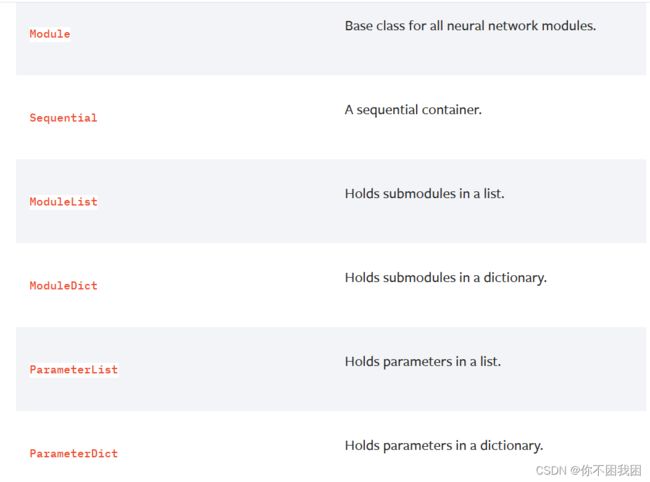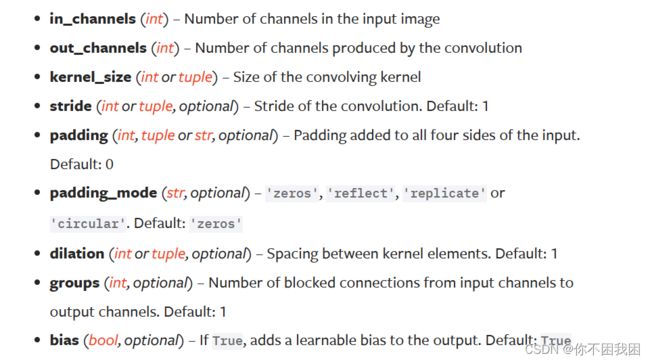神经网络入门
神经网络的基本骨架
1. nn.Module的使用
- 所有的模型都要继承 Module 类
- 需要重写初始化函数和运算步骤函数
eg:
import torch.nn as nn
import torch.nn.functional as F
class Model(nn.Module): # 继承父类Module
def __init__(self): # 重写初始化函数
super().__init__() # 调用父类初始化
self.conv1 = nn.Conv2d(1, 20, 5)
self.conv2 = nn.Conv2d(20, 20, 5)
def forward(self, x): # 神经网络的运算步骤--前向传播
x = F.relu(self.conv1(x)) # x->卷积->非线性
return F.relu(self.conv2(x)) # x->卷积->非线性
代码示例:
import torch
from torch import nn
class Kun(nn.Module):
def __init__(self):
super().__init__()
def forward(self, input):
output = input+1 # 实现输出加1
return output
kun = Kun()
x = torch.tensor(1.0)
output = kun(x)
print(output) # tensor(2.)
2. 卷积
conv2可选参数
卷积计算过程示意:
import torch
# 输入图像(5*5)
input = torch.tensor([[1, 2, 0, 3, 1],
[0, 1, 2, 3, 1],
[1, 2, 1, 0, 0],
[5, 2, 3, 1, 1],
[2, 1, 0, 1, 1]]) # 输入tensor数据类型的二维矩阵
# 卷积核
kernel = torch.tensor([[1, 2, 1],
[0, 1, 0],
[2, 1, 0]])
print(input.shape)
print(kernel.shape)
torch.Size([5, 5])
torch.Size([3, 3])
如果不调整尺寸会报错:Expected 3D(unbatched) or 4D(batched) input to conv2d, but got input of size: [5, 5]
所以需要调整
input = torch.reshape(input, (1, 1, 5, 5))
kernel = torch.reshape(kernel, (1, 1, 3, 3))
output = F.conv2d(input, kernel, stride=1)
print(output)
--------------------------------------------------------------------------
tensor([[[[10, 12, 12],
[18, 16, 16],
[13, 9, 3]]]])
stride可以选择移动的步长
output2 = F.conv2d(input, kernel, stride=2)
print(output2)
----------------------------------------------------------------------------
tensor([[[[10, 12],
[13, 3]]]])
padding进行填充(默认填充0)
output3 = F.conv2d(input, kernel, stride=1, padding=1)
print(output3)
-----------------------------------------------------------------------------
tensor([[[[ 1, 3, 4, 10, 8],
[ 5, 10, 12, 12, 6],
[ 7, 18, 16, 16, 8],
[11, 13, 9, 3, 4],
[14, 13, 9, 7, 4]]]])
示例代码:
import torch
import torch.nn.functional as F
# 输入图像(5*5)
input = torch.tensor([[1, 2, 0, 3, 1],
[0, 1, 2, 3, 1],
[1, 2, 1, 0, 0],
[5, 2, 3, 1, 1],
[2, 1, 0, 1, 1]]) # 输入tensor数据类型的二维矩阵
# 卷积核
kernel = torch.tensor([[1, 2, 1],
[0, 1, 0],
[2, 1, 0]])
# 调整输入的尺寸
# 如果不调整尺寸会报错
# Expected 3D(unbatched) or 4D(batched) input to conv2d, but got input of size: [5, 5]
input = torch.reshape(input, (1, 1, 5, 5))
kernel = torch.reshape(kernel, (1, 1, 3, 3))
# print(input.shape) # torch.Size([1, 1, 5, 5])
# print(kernel.shape) # torch.Size([1, 1, 3, 3])
output = F.conv2d(input, kernel, stride=1)
print(output)
output2 = F.conv2d(input, kernel, stride=2)
print(output2)
output3 = F.conv2d(input, kernel, stride=1, padding=1)
print(output3)


